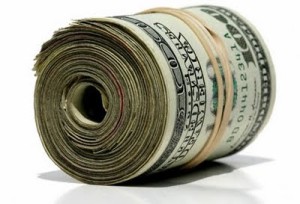
Contents
In a previous post I discussed what it means to assume that poker earn rate is normally distributed. I will be using that assumption as the basis for calculating the figures used in this article.
Winnie the Winner and Larry the Loser
I would like to introduce you to two of my imaginary friends. They both play a lot of limit hold’em and remarkably I know that their earn rates are indeed normally distributed.
Winnie (the winner) has an earn rate of 2 big bets per hundred hands and a standard deviation of 19
Larry (the loser) has an earn rate of –1 bb/100 and a standard deviation of 26.
The Very Next Hand
Statistical investigations are only meaningful when you have lots and lots of data. But let’s look up really closely at the very next hand.
Since we know nothing about the hand the only thing we can say is “we expect Winnie to win 0.02 big bets per hand and Larry to lose 0.01 big bets per hand”. We can also assume that since Winnie is a long term winning player she is playing good poker and sees about 25% of flops. So she earns nothing 75% of the time and 0.08 big bets per hand for the other 25%. We could not make similar assumptions about Larry.
We could also make other observations as we zoom out slightly. If we know the players’ positions then for Winnie it would be higher the closer she was to the button and we could probably define this increment if we had enough data. Larry would probably lose uniformly from all positions.
If we knew which hand the player held we could better predict the value of the next hand. Both players would probably have similar earn rates for pockets aces (something in the region of 3 big bets). Whilst Larry would get more action Winnie would know when to fold or stop raising. On most hands Winnie would be expecting to lose slightly less than cost of paying for them when she gets them in the blinds. Larry’s expected value for most hands will be negative and would only be positive for the very best starting hands.
Let’s zoom out slightly.
One Hundred Hands
Since know the earn rate distributions let’s see what we can expect over the next hundred hands:
(you may recognise some of Winnie’s numbers from last month’s article)
Winnie can expect over the next 100 hands to:
lose 30 big bets or more one time in 22
win 30 big bets or more one time in 14
be in profit only 54% of the time.
Larry can expect over the next 100 hands to:
lose 30 big bets or more one time in 8
win 30 big bets or more one time in 9
be in profit only 48.5% of the time.
Larry’s earn rate has a higher standard deviation than Winnie’s. Look how more frequently he has extreme short term results.
We can also create a new distribution out of the two we have.
To summarise from above:
Winnie’s earn rate is Normally distributed with mean 2 and standard deviation 19.
Larry’s earn rate is Normally distributed with mean -1 and standard deviation 26.
Therefore we can say that the amount that Winnie earns more than Larry over the next 100 hands is Normally distributed with mean 3.
The standard deviation from adding two Normal distributions is not as easy to get as the mean… but it’s not rocket science either… we square the two standard deviations and then …. add them …and then square root the answer…. Easy huh?
So in this case ?(192 + 262) = 32.2
So over the next 100 hands Winnie can expect to win more than Larry only 54% of the time!
Let’s zoom out a little further.
Then Two Hundred Hands
Since we are assuming that earn rates are normally distributed we can use its properties to get a distribution of earn rate for more than a hundred hands. The general formula we will use is that for n-hundred hands the amount a player can expect to earn is normally distributed with:
mean = n × mean (for a hundred)
and standard deviation = ?(n)× standard deviation (for a hundred)
So for 200 hands:
Winnie’s earn rate is Normally distributed with mean 4 and standard deviation 26.9 (19×?2)
Larry’s earn rate is Normally distributed with mean -2 and standard deviation 36.8
Winnie’s minus Larry’s is Normally distributed with mean 6 and standard deviation 45.5
So,
Winnie can expect over the next 200 hands to:
lose 60 big bets or more one time in 116
win 60 big bets or more one time in 54
be in profit only 56% of the time.
Larry can expect over the next 200 hands to:
lose 60 big bets or more one time in 17
win 60 big bets or more one time in 22
be in profit only 47.8% of the time.
Notice how really extreme results are becoming even less likely for Winnie and also for Larry. The probability of being ahead is increasing slightly for Winnie and decreasing slightly for Larry.
Over the next 200 hands Winnie can expect to win more than Larry only 55% of the time!
Right, let’s really zoom further out now…
2k Hands OK
After 2,000 hands … (2,000 = 20 hundred)
Winnie’s earn rate is Normally distributed with mean 40 and standard deviation 85
Larry’s earn rate is Normally distributed with mean -20 and standard deviation 116
Winnie’s minus Larry’s is Normally distributed with mean 60 and standard deviation 144
So,
Winnie can expect over the next 2,000 hands to:
lose 600 big bets or more one time in 3,967,9291,871,105
win 600 big bets or more one time in 45,395,071,288
be in profit 68% of the time.
Larry can expect over the next 2,000 hands to:
lose 600 big bets or more one time in 3,275,733
win 600 big bets or more one time in 20,563,796
be in profit only 43% of the time.
As we move further away from a few hands earn rate begins to dominate over standard deviation. Extreme outcomes become less and less likely, especially for Winnie who has a lower standard deviation. By the time we get to 2,000 hands extreme results are becoming outrageously unlikely. Our long term winning player is much more likely to be in profit that our long term loser.
Over the next 2,000 hands Winnie can expect to win more than Larry only 66% of the time!
I chose the extreme amounts to look at as 15 times the amount Winnie expected to earn. You can use any number you want when looking at the extremes. I just chose 15 because it seemed pretty extreme to me.
100k and a Million
Let’s zoom right out and look at some of the key results.
After 100,000 hands:
Winnie will be in profit 99.96% of the time
And she will be ahead of Larry 99.84% of the time
After 1,000,000 hands:
Winnie will be in profit 100% of the time
And she will be ahead of Larry 100% of the time
It’s obviously not exactly 100% but it’s so close I couldn’t get excel to show me where the decimals start running.
Perspective
You will always hear expert poker players emphasising the “long term”. There is good reason for this. Poker is fundamentally a game of striving to do the right thing whilst ignoring short term results. In order to really succeed in poker you have to really believe that things will work out in the long run.
Whilst writing this article I have had a terrible downswing badly deepened by tilt. Working out these numbers made me realise something important. Bad players, most specifically maniacs, have extreme short term results. You are more likely to see a terrible player leave the table with more than 60 big bets after 100 hands than you are to see a good player do so.
Don’t be seduced by this. Don’t get gambling fever. By the time we get to the long term all the losers will be losers and all the winners will have won. See you there ?
Leave a Review
Submit your review | |







